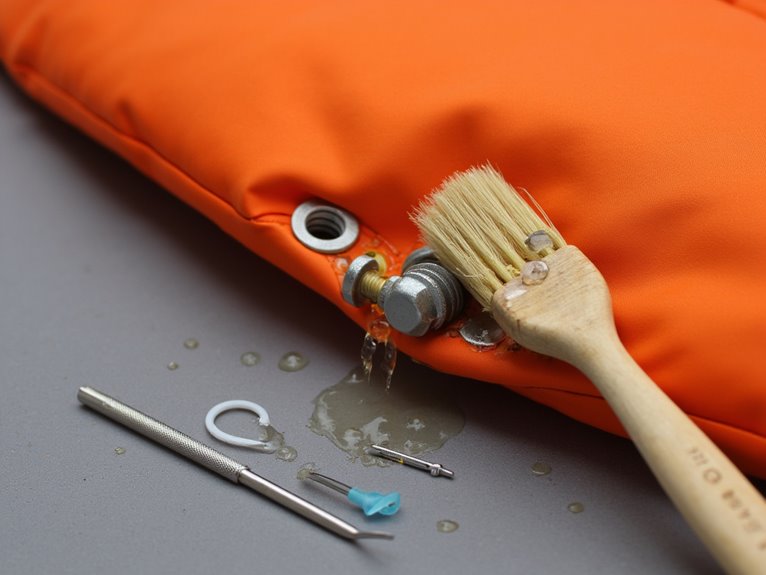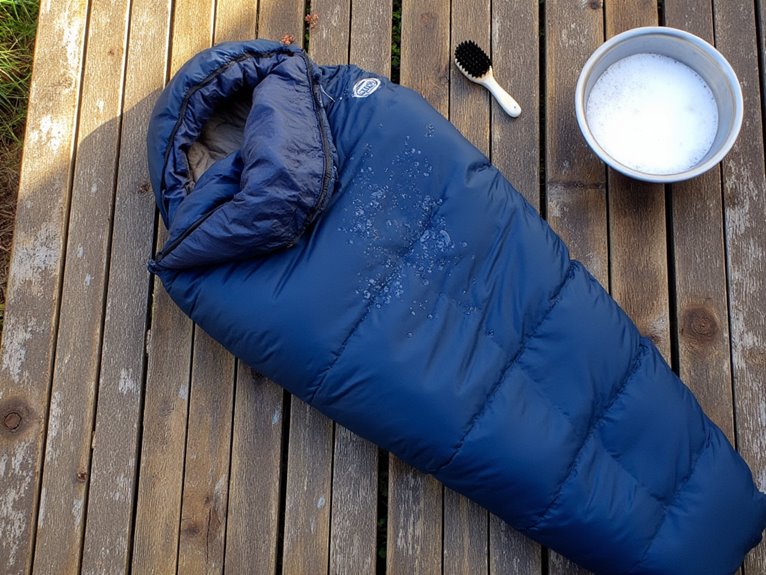Sleeping Pad Valve Care and Maintenance Guide
You’ll maintain your sleeping pad’s valve system through monthly O-ring inspections for cracks or deformation, quarterly deep cleaning with mild soap while keeping valves closed, and proper leak detection using soapy water bubble tests. Store self-inflating pads semi-inflated with valves open in dry locations, avoiding compression in stuff sacks. Air dry completely before storage and test valve stem operation regularly for smooth pressing and pulling action. These systematic protocols reveal advanced techniques that prevent costly valve failures.
We are supported by our audience. When you purchase through links on our site, we may earn an affiliate commission, at no extra cost for you. Learn more. Last update on 5th December 2025 / Images from Amazon Product Advertising API.
Notable Insights
- Test valve functionality by listening for hissing, checking alignment, and applying soapy water to detect air leaks.
- Clean valve exteriors with mild soap and damp cloths while keeping valves securely closed to prevent water ingress.
- Store self-inflating pads semi-inflated with valves open in dry locations to prevent foam compression and moisture buildup.
- Inspect O-rings monthly for cracking or deformation and perform quarterly deep cleaning with non-detergent soap.
- Replace damaged valves by removing old valve, cleaning area thoroughly, applying adhesive, and curing for three hours.
Essential Valve Inspection Techniques
Five critical inspection techniques form the foundation for maintaining your sleeping pad’s valve system and preventing field failures.
Begin your valve functionality analysis by listening for hissing sounds during inflation and checking that valve caps align correctly without cracks or deformation. Examine all components for wear, damage, or debris obstruction.
Your leak detection strategies should include inflating the pad to maximum firmness, then applying soapy water around valve areas while watching for telltale bubbles.
If surface testing proves inconclusive, carefully submerge the valve underwater to detect escaping air.
Test the check mechanism by pressing and pulling the valve stem to verify smooth operation and proper seating.
Finally, examine the valve base attachment, housing integrity, and surrounding pad fabric for stress indicators that could compromise future performance.
Proper Cleaning Methods for Valve Protection
Once you’ve identified potential valve issues through systematic inspection, proper cleaning becomes your primary defense against premature valve failure and compromised seal integrity.
Keep valves securely closed during valve cleaning to prevent water ingress into internal mechanisms. Never submerge valves or apply cleaning agents directly inside valve openings.
Maintain valve integrity by keeping them closed during cleaning and avoiding direct water or chemical contact with internal components.
Use mild, non-detergent soaps or dedicated gear washes designed for delicate valve materials. Wipe valve exteriors gently with soft, damp cloths to remove debris without excessive moisture.
For mold near valves, apply diluted vinegar solution (1:4 ratio) cautiously around valve edges without flooding mechanisms.
Air dry pads with valves open, avoiding direct sunlight exposure that degrades valve materials. Use low-heat hair dryers held over, not inside, valves.
Store pads with valves partially opened post-cleaning to maintain flexibility.
Optimal Storage Practices for Valve Longevity
While proper cleaning protects your valve’s immediate function, strategic storage practices determine whether those valve seals maintain their integrity for years or fail within seasons.
Ideal storage locations include indoor closets, under beds, or dedicated gear spaces with stable temperature and humidity. Avoid damp basements, garages, and attics where moisture degrades valve components.
Store self-inflating pads semi-inflated with valves open to prevent foam compression risks that permanently damage internal structure. Air pads should hang loosely or lie flat rather than compressed in stuff sacks. Keep valve caps removed to promote air circulation and prevent pressure buildup.
Ensure pads are completely dry before storage, as trapped moisture accelerates valve seal deterioration.
Vary rolling patterns to prevent stress concentration near valve assemblies, extending operational lifespan remarkably.
Step-by-Step Valve Repair Process
Even the most meticulously maintained valve assemblies can fail due to material fatigue, manufacturing defects, or unexpected trauma in the field. Valve compatibility assessment becomes critical before beginning repairs. Match your replacement valve to the original specifications and thread patterns.
| Step | Action | Time Required |
|---|---|---|
| 1 | Remove old valve with pliers | 5 minutes |
| 2 | Clean area with soap and alcohol | 10 minutes |
| 3 | Apply adhesive to new valve | 2 minutes |
| 4 | Install and seat valve properly | 3 minutes |
| 5 | Test inflation after curing | 3+ hours |
Adhesive selection tips require matching chemical compatibility with your pad material. Apply thin layers around the barbed valve end. Allow three-hour minimum curing time before testing.
Preventive Maintenance for Long-Term Valve Health
Regular valve maintenance prevents costly failures and extends your sleeping pad’s operational lifespan by years rather than months.
Systematic valve care protocols transform sleeping pad reliability from seasonal equipment into multi-year backcountry investments.
These preventive measures directly impact valve longevity through systematic care protocols.
Implement this maintenance schedule for prime performance:
- Monthly O-ring inspection – Check for cracking, hardening, or deformation that compromises seal integrity.
- Quarterly deep cleaning – Use mild, non-detergent soap solutions while keeping valves closed during surface cleaning.
- Pre-storage preparation – Verify complete drying and store with valves open in temperature-controlled environments.
- Post-use assessment – Test inflation/deflation function and inspect for wear indicators after each trip.
Store pads uncompressed and flat to maintain structural integrity.
Temperature extremes accelerate material degradation, particularly affecting rubber components.
Replace O-rings showing aging signs immediately. This proactive approach prevents field failures and maintains reliable performance across hundreds of inflation cycles.
Following manufacturer guidelines not only protects your investment but ensures warranty coverage remains valid throughout your sleeping pad’s service life.





